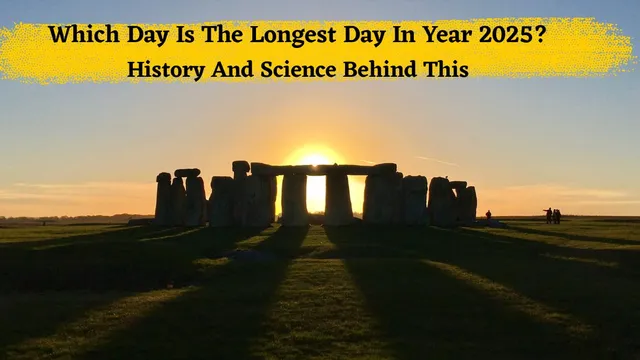- By Aditi Priya Singh
- Wed, 18 Jun 2025 04:07 PM (IST)
- Source:JND
Summer Solstice: The longest day on Earth, also known as the Summer Solstice, is a significant astronomical event that marks the onset of summer in the Northern Hemisphere. The longest day on Earth isn't just a random occurrence, but it's because of our planet Earth’s axial tilt and its orbit around the Sun. Earth's axis is tilted at approximately 23.5 degrees relative to its orbital plane (the plane in which it revolves around the Sun). This tilt, rather than our distance from the Sun, is the primary cause of seasons.
Which Day is the Longest Day Of the Year? Science Behind The Longest Day
In 2025, June 20 will be the longest day of the year because the Northern Hemisphere will be tilted towards the Sun, receiving more direct sunlight at that time. Due to this tilt, the Sun's rays strike the Earth at a more direct angle, which causes longer days and more warmth. The duration of daylight varies depending on the latitude, with places closer to the poles experiencing more significant differences in day length.
What is the Summer Solstice?
-1750242978606.jpg)
Which day is longest day in 2025 (Image: Canva)
The longest day of the year is called the Summer Solstice because it marks the moment when the Sun is at its highest point in the sky, resulting in the longest period of daylight. This occurs when the North Pole is tilted maximally towards the Sun, causing the Northern Hemisphere to receive more direct sunlight and experience longer days and warmer temperatures. In 2025, the Summer solstice will occur from Friday, June 20, to Saturday, June 21, with the exact moment happening at 10:42 p.m. EDT on June 20 or 2:42 GMT on June 21.
The word "solstice" itself is derived from the Latin words "sol" (sun) and "stitium" (to stand motionless). For a few days around the solstice, ancient observers saw the Sun seem to pause in its northward (or southward) motion across the sky before turning around. The name came from this "standing still."
It's important to keep in mind that although the summer solstice is the longest day of the year, it's not usually the hottest. Because it takes time for the Earth's land masses and oceans to absorb and release heat, there is a lag in temperature. The hottest average temperatures typically happen in late July or early August, a few weeks after the solstice.
Duration of the Longest Day
The length of the longest day varies depending on the location. For instance:
- In Whitehorse, Canada, the longest day will last for 19 hours and 9 minutes.
- In Bogota, Colombia, near the equator, the longest day will be approximately 12 hours and 23 minutes.
- Places within the polar circles experience the Midnight Sun or polar day, where the Sun remains above the horizon for several days or months.
History and Cultural Significance
-1750242995815.jpg)
Science behind the summer solstice (Image: Canva)
Throughout history, many cultures have observed the Summer Solstice. Numerous ancient societies understood the importance of this occasion and erected monuments that matched the Sun's solstice position. People from all walks of life still commemorate this occasion today with their customs and rituals.
Stonehenge in England: A UNESCO World Heritage Site in England, Stonehenge is a prehistoric monument where thousands of people gather to celebrate the summer solstice and watch the sunrise align with ancient stones that have a rich spiritual and historical significance.
Ancient Egypt: Although there is no concrete proof of solstice celebrations in ancient Egypt, their calendar was based on the stars and the flooding of the Nile, suggesting a potential link to seasonal variations and solar events.
Northern and Central Europe: Ancient societies in Northern and Central Europe celebrated Midsummer with bonfires, dancing, and feasting because they thought the sun's warmth had healing and protective properties. This highlights the importance of solstice celebrations.
China: Chinese solstice celebrations have a long history that dates back to the Han Dynasty, when ceremonies and rituals were carried out to mark the start of the yin season (winter), which symbolises the harmony of the universe and nature. Eating chilled noodles is also a common tradition in some regions.
How do People celebrate the summer solstice?
People celebrate the summer solstice with festivals, bonfires, and rituals. Many gather at ancient sites like Stonehenge to witness the sunrise. Others participate in cultural events, dancing, and feasting, symbolising renewal, growth, and the triumph of light over darkness, embracing the longest day of the year.

